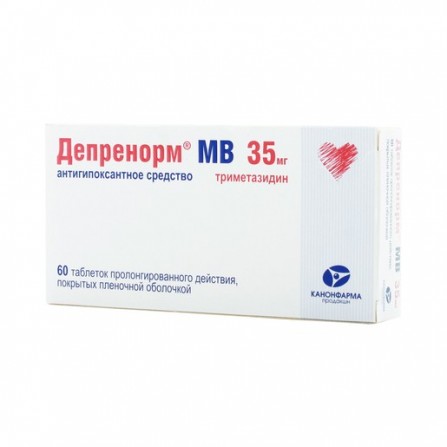Deprenorm mv coated pills with a modified release of 35mg N60
Condition: New product
998 Items
Rating:
Be the first to write a review!

More info
Active ingredients
Trimetazidine
Release form
Pills
Composition
Active ingredient: Trimetazidine dihydrochloride Concentration of active ingredient (mg): 35
Pharmacological effect
A drug that improves myocardial metabolism. It has an antihypoxic effect with stable angina. Directly affecting the cardiomyocytes and neurons of the brain, optimizes their metabolism and function. The cytoprotective effect is due to an increase in energy potential, activation of oxidative decarboxylation and rationalization of oxygen consumption (increased aerobic glycolysis and blockade of fatty acid oxidation), in the reduction of myocardial contractility, in the same way, to prevent a safer heartbeat, a secure heartbeat, and a secure heart, and myopathy, will be prevented by a non-myocardial contraction, and a secure heartbeat, and a secure heartbeat, and a secure heartbeat, and a secure heart, and myocardial contractility, and a secure heart, and myocardial contractility, and the blockade of oxidation of fatty acids) and a myocardial contractility, and a secure heart, and myocardial contractility, and myocardial contractility, and the blockade of fatty acid oxidation, can be prevented. creatine phosphate. Under conditions of acidosis, it normalizes the functioning of membrane ion channels, prevents the accumulation of calcium and sodium in cardiomyocytes, and normalizes the intracellular content of potassium ions. Reduces intracellular acidosis and phosphate content due to myocardial ischemia and reperfusion. Interferes with the damaging effects of free radicals, preserves the integrity of cell membranes, prevents activation of neutrophils in the ischemic area, increases the duration of electrical potential, reduces the release of creatine phosphokinase from cells and the severity of ischemic damage to the myocardium. Trimetazidine reduces the frequency of strokes (decreases nitrate consumption), after 2 weeks of the drug increased exercise tolerance, reduced sharp fluctuations in blood pressure. Dizziness and tinnitus are reduced. In case of vascular eye pathology, the functional activity of the retina of the eye improves.
Pharmacokinetics
AbsorptionAfter ingestion is rapidly and almost completely absorbed from the gastrointestinal tract. Bioavailability is 90%. Cmax is reached after 5 hours. Distribution Plasma protein binding is 16%. Css is reached in 60 hours. Vd is 4.8 l / kg, which implies a good distribution in the tissues. Easily penetrates histohematogenous barriers. Excretion is excreted by the kidneys, about 60% - unchanged. T1 / 2 is about 7 hours. The pharmacokinetics in special clinical situations T1 / 2 in patients over the age of 65 years is about 12 hours. The kidney clearance of trimetazidine directly correlates with CC, hepatic clearance decreases with age.
Indications
Ischemic heart disease: prevention of attacks of stable angina (as part of combination therapy), chorioretinal disorders with the ischemic component, vestibular-cochlear disorders of ischemic nature, such as dizziness, tinnitus, hearing loss.
Contraindications
Hypersensitivity to any component of the drug, severe renal failure (CC below 15 ml / min), marked impaired liver function, pregnancy, breastfeeding period, age up to 18 years (efficacy and safety have not been established).
Precautionary measures
Do not exceed recommended doses.
Use during pregnancy and lactation
The drug is contraindicated in pregnancy due to the lack of clinical data on the safety of its use. It is not known whether trimetazidine is excreted in breast milk. If necessary, the use of the drug during lactation should stop breastfeeding.
Dosage and administration
Inside, during meals. Deprenorm MB take 1 tablet 2 times a day (morning and evening). The course of treatment is recommended by the doctor.
Side effects
The frequency of side effects noted when taking trimetazidine is given in the following gradation: very often (more than 1/10); often (more than 1/100, less than 1/10); infrequently (more than 1/1000, less than 1/100); rarely (more than 1/10000, less than 1/1000); very rarely (less than 1/10000), including individual messages. From the digestive system. Frequently: abdominal pain, diarrhea, dyspepsia, nausea, vomiting. From the central nervous system. Frequently: dizziness, headache, asthenia. Very rare: extrapyramidal disorders (tremor, rigidity, akinesia), reversible after discontinuation of the drug. On the skin side. Frequently: skin rash, itching, urticaria. On the side of the cardiovascular system. Rare: orthostatic hypotension, blood flushes to the skin of the face.
Overdose
Data on overdose cases is limited. Treatment: in case of overdose, symptomatic therapy should be carried out.
Interaction with other drugs
Interaction with other drugs is currently not established.
special instructions
The drug is not intended to relieve angina attacks, for the initial course of treatment of stable angina or myocardial infarction. When developing angina attacks, the therapy should be reviewed. The effect on the ability to drive vehicles and control mechanisms. The use of the drug does not affect the ability to drive and work,requiring increased speed of psychomotor reactions.




